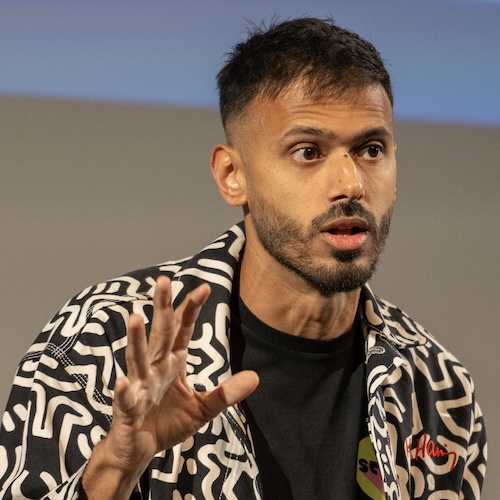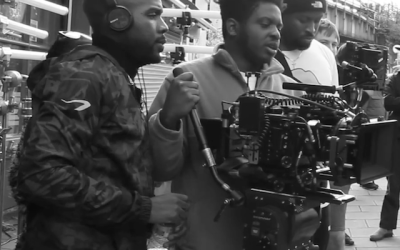It’s an exciting time to be a documentary-maker, and not just creatively. The digital-first world is presenting opportunities to rethink the business models for factual content, from new ways of funding projects to brand partnerships and leveraging niche audiences.
The opening panel at the TellyCast Digital Content Forum in London today brought together some of the innovators in this space: Serena Jones (The B1M); Ben Zand (Zandland); Yusef Omar (Seen·tv); and Gerrit Kemming (Quintus Studios, which sponsored the session); with Creatorville’s Sam Barcroft moderating.
B1M is a YouTube-first channel talking about the built environment: construction and architecture. “We love a skyscraper!” laughed Jones, before talking about the company’s business model: a mixture of YouTube ad revenues and brand partnerships.
“We have a lot of sponsorships that are quite unique to us, because we’re trusted when we talk about construction. We’re quite dialled in to that industry,” she said, explaining that its channel attracts general viewers – people interested in buildings – as well as industry professionals.
“You have to cater to people who know way too much about the subject, and also people who know absolutely nothing. You can’t blag it. You have to be authentic,” said Jones. “As long as people know they can trust you, they’ll listen to what you have to say.”
Seen.tv, meanwhile, was launched as an alternative to the mainstream media, training an army of mobile journalists to film content for its shows, which are then distributed through various platforms to its community of subscribers.
“Those subscribers have generated $18bn – we get half of it – in programmatic ad revenues,” said Omar, adding that the company’s focus is on “unseen audiences” around taboos and under-reported subjects. Menstrual health being one example.
“Why is it a stigma? Half the world’s population does this. We leaned into that audience, and today 70% of our audience are 13-24 year-old women,” said Omar. He also talked about the under-served audience of Muslim people – more than two billion around the world.
“They don’t have a Disney. They don’t have a Netflix. They don’t have many media organisations who cater to that audience,” he said.
Seen.tv is also building a direct subscriptions business, freeing itself from being solely dependent on the social and video services’ recommendation algorithms to reach its community and generate revenues.
Omar talked up the revenue opportunities in going beyond the traditional topics, citing one example of content generating six-figure revenues. “You can’t make that kind of money without taking your clothes off!” he joked. But Seen.tv is managing it.
Zandland is in a similar area: a multi-channel production company that is also trying to tell stories and centre people who aren’t given much space in traditional media.
“People come to us because we genuinely can get access to people you wouldn’t usually get access to,” he said. Zandland started as a production company, but now “100% the trajectory is as a studio, whether that’s a studio in the sense that we will self-fund content that we create… or we place it on our platforms and get advertising revenue.”
“The actual short-term way to make cash is through brand partnerships,” added Zand. “And then it’s just building that to the point of a subscription model with some individuals who want independently-minded journalism content. There’s so much demand for journalism online: a whole world of young people going out and seeing the world, and making money from it.”
Zand added that his company is fielding a lot of inbound interest from brands. “They want on-the-ground, edgy-feeling content. If you’re a brand that wants to feel raw and have that authenticity, that’s a very appealing concept.”
Kemming talked about how Quintus Studios is going about its business of production and distribution, having evolved from a TV-focused company into a digital-first operation.
“We’re coming from the TV space. I started Quintus as a distribution agency in 2011, but from 2014-15 on we grew into being a channel network,” he said. “We are now producing for our channels, and then sell this as a secondary mode to TV.”
“We have a growing network of really talented filmmakers all over the world. They know what’s working for us, so when they have a cool story they will come and pitch it to us,” he added.
Broadcasters are keen on this material, even when it is already available on YouTube, said Kemming. However, Quintus is willing to be flexible in its dealmaking.
“If the money is really big [from a linear broadcaster] we’ll say ‘you take it first, we’ll take it second’,” he explained, before outlining some challenges: among them the need to bring production costs down, even if technology can help with that.
The panel finished with some tips on how to scale a digital-first documentaries business.
“It’s about not just making a massive leap from where you are, [but about] knowing what you’re doing,” said Jones, giving the example of why it would be illogical for The B1M to diversify from construction into, say, gaming. “It’s about making sure you’re still staying in your lane, building it out, not making a massive leap.”
Omar talked about his plans to “go longer-form, deeper forms of engagement, more into interactivity… Start the investment small, get good data and signals in, and doing that at massive scale.” And then making investments in more ambitious projects accordingly.
Zand said he is excited about how affordable it is to self-produce content, put it out and then find revenue streams, be they ads or TV sales. “Podcasts are exciting and extremely cheap to make,” he added. “I’m focused on leverage, in terms of creating a brand of Zandland that people want to watch, whether that’s a digital series on our channel, or Zandland on Netflix.”
Meanwhile, Kemming sees plenty of room to grow Quintus Studios’ core business: “more channels and making the core channels bigger,” he said. But he is excited about the opportunity to fill some of the gaps that are opening up in TV commissioner’s schedules, and of figuring out “what are documentaries for the millennial audience… that will also open up the brand-money side.”





